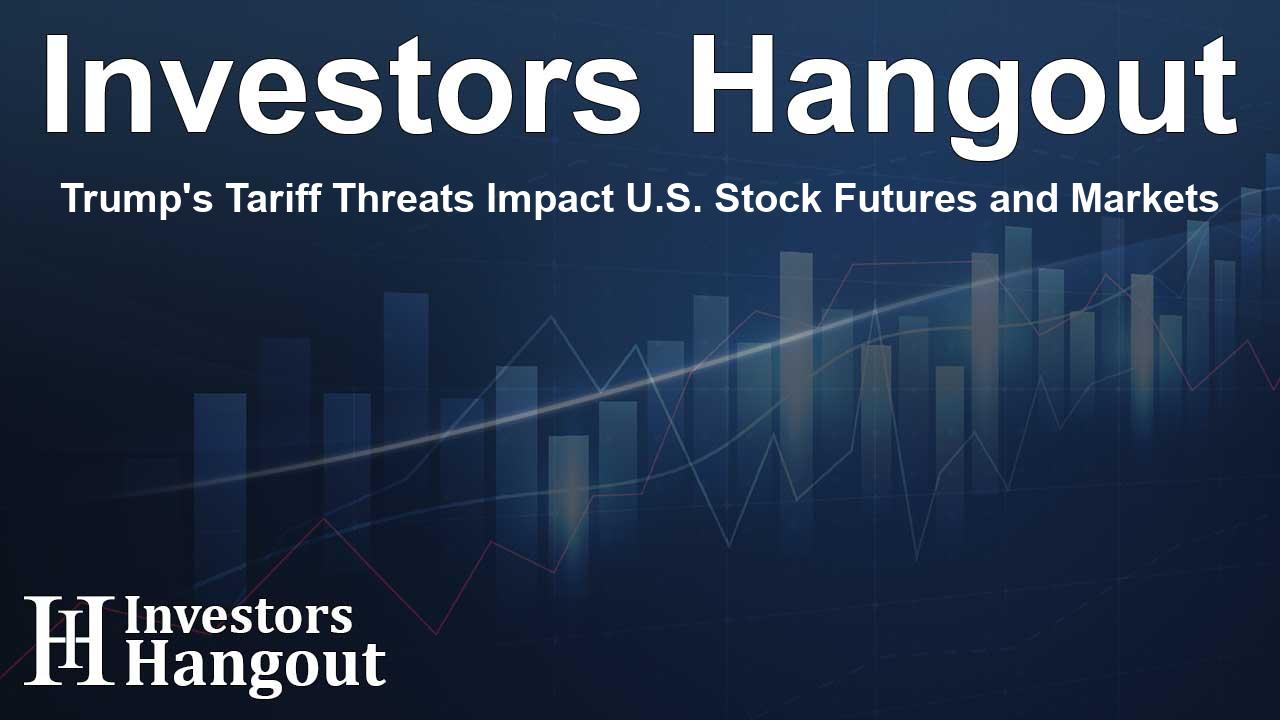Trump's Tariff Threats Impact U.S. Stock Futures and Markets

Market Reaction to Tariff Threats
U.S. stock index futures experienced a downturn after President-elect Donald Trump threatened to impose increased import tariffs, impacting investor sentiment. The implications of his remarks on tariffs covering countries like China and Canada have introduced a wave of concern among market participants.
S&P 500 Futures dipped by 0.3%, settling at 5,989.75 points, while the Nasdaq 100 Futures also fell by 0.3%, reaching 20,817.75 points. Moreover, Dow Jones Futures recorded a similar drop, ending at 44,707.0 points. The early gains observed in the market were quickly overshadowed by Trump's announcements, disrupting the positive tone established from a previously bullish session on Wall Street.
The market had initially responded positively to other news, especially the nomination of Scott Bessent as Treasury Secretary. Investors viewed this as a sign of potentially supportive fiscal policies, boosting their confidence in cyclical sectors. However, the announcement of potential tariffs drastically altered market trajectories.
Understanding Trump's Tariff Proposals
Trump's social media post outlined a warning of an additional 10% tariff on Chinese imports, emphasizing the urgency of addressing the illegal drugs matter infiltrating the United States. This comes in conjunction with his earlier commitment to enforce a significant 60% tariff on all imports from China.
Moreover, he proposed a 25% tariff on goods from Canada and Mexico, aimed at addressing issues of illegal immigration and drug flow through these nations. Such aggressive tariff measures raised alarms about a potential resurgence of a global trade conflict, echoing the uncertainties faced during much of Trump's first term.
The currency market reacted swiftly, with the dollar and Treasury yields experiencing notable increases following these tweets, indicating heightened tensions in global economic interactions.
Wall Street's Initial Optimism and Its Shift
Prior to the tariff announcements, Wall Street had recorded strong market performance, particularly boosted by Trump’s nomination of Scott Bessent. As a veteran investor, Bessent's appointment was embraced as a likely pathway to progressive tax reforms that could support U.S. businesses.
Positive investor sentiment led to impressive gains in economically sensitive sectors, reinforcing bets on more expansionary measures under the incoming administration. The Dow Jones Industrial Average surfaced as a leader in the index, achieving a remarkable record high of 44,746.57 points, reflecting a rise of 1%. Meanwhile, the S&P 500 edged up 0.3% to land at 5,987.37 points, and the NASDAQ Composite also registered a 0.3% increase, concluding at 19,054.89 points.
Despite these advancements, trading activities are anticipated to be limited this week primarily due to the Thanksgiving holiday, coupled with traders awaiting key economic indicators to guide investments.
Future Perspectives: Economic Data Ahead
Markets are now bracing themselves for critical economic reports, particularly the PCE price index, which the Federal Reserve considers as its primary gauge of inflation trends. This important economic announcement is set to be released soon, with expectations of affecting market perceptions as it relates to upcoming monetary policy decisions. Investors continue to navigate the complex landscape shaped by tariff discussions, election outcomes, and economic indicators, setting the stage for potentially impactful changes in market dynamics.
Frequently Asked Questions
What triggered the decline in U.S. stock futures?
The decline in U.S. stock futures was primarily triggered by Trump's threats to impose higher import tariffs on several countries, raising concerns about trade relations.
How did the stock market respond before the tariff threats?
Before the tariff threats, the stock market was performing positively, driven by the nomination of Scott Bessent for Treasury Secretary and investor optimism in cyclical sectors.
What specific tariffs did Trump propose?
Trump proposed a 10% tariff on all Chinese imports, a 25% tariff on imports from Canada and Mexico, and mentioned earlier plans for a massive 60% tariff on Chinese goods.
What impact did the tariffs have on the dollar and Treasury yields?
The announcement of the tariff threats caused a surge in both the dollar and Treasury yields, reflecting increased market volatility and concerns about trade conflicts.
What upcoming economic data should investors watch for?
Investors should watch for the upcoming PCE price index data, as it is a key indicator for Federal Reserve policies and could influence market reactions.
About Investors Hangout
Investors Hangout is a leading online stock forum for financial discussion and learning, offering a wide range of free tools and resources. It draws in traders of all levels, who exchange market knowledge, investigate trading tactics, and keep an eye on industry developments in real time. Featuring financial articles, stock message boards, quotes, charts, company profiles, and live news updates. Through cooperative learning and a wealth of informational resources, it helps users from novices creating their first portfolios to experts honing their techniques. Join Investors Hangout today: https://investorshangout.com/
Disclaimer: The content of this article is solely for general informational purposes only; it does not represent legal, financial, or investment advice. Investors Hangout does not offer financial advice; the author is not a licensed financial advisor. Consult a qualified advisor before making any financial or investment decisions based on this article. The author's interpretation of publicly available data shapes the opinions presented here; as a result, they should not be taken as advice to purchase, sell, or hold any securities mentioned or any other investments. The author does not guarantee the accuracy, completeness, or timeliness of any material, providing it "as is." Information and market conditions may change; past performance is not indicative of future outcomes. If any of the material offered here is inaccurate, please contact us for corrections.